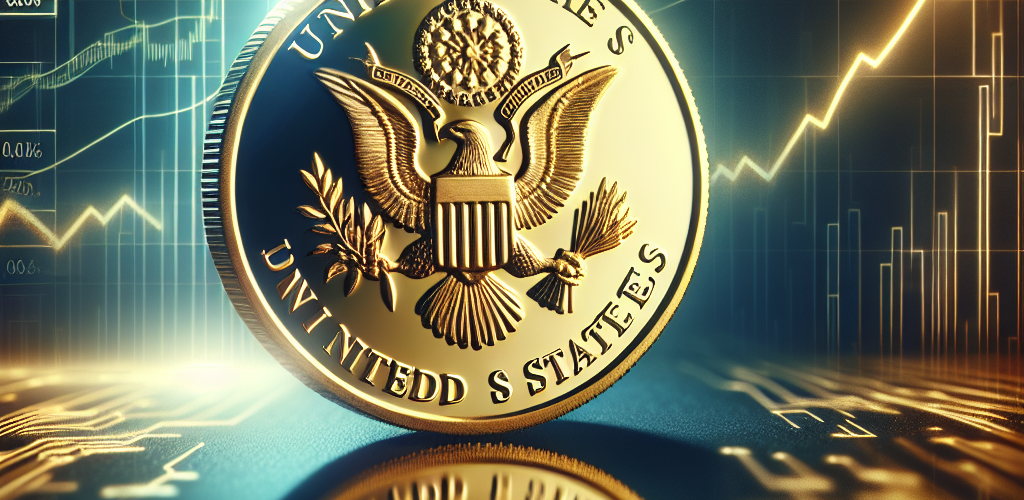If you’ve ever considered adding gold coins to your investment portfolio, you may be wondering, “Are US gold coins a good investment?” With their allure and historical significance, US gold coins have long been sought after by collectors and investors alike. In this article, we will explore the potential benefits and considerations of investing in US gold coins, helping you make an informed decision about whether they are a wise investment choice for you.

Historical performance of US gold coins
Overview of the performance of gold coins
When considering investing in US gold coins, it is vital to understand their historical performance. Gold coins have maintained their value and acted as a reliable store of wealth throughout history. For centuries, gold has been prized for its scarcity, durability, and intrinsic value. This enduring demand has resulted in a consistent appreciation of gold prices over time.
Comparison between US gold coins and other types of gold investments
US gold coins have proven to be a popular choice for investors looking to benefit from the performance of gold. Compared to other types of gold investments, such as gold bars or gold exchange-traded funds (ETFs), US gold coins offer several advantages. They provide investors with a tangible asset that can be held physically, adding a sense of security and ownership.
Factors that affect the value of US gold coins
The value of US gold coins can be influenced by various factors. The key determinants include the gold content and purity of the coins, their rarity or numismatic value, and the overall condition and grade. Additionally, market demand, economic conditions, and global gold trends can also impact the value of US gold coins.
Advantages of investing in US gold coins
Tangible asset with intrinsic value
One fundamental advantage of investing in US gold coins is that they are tangible assets with inherent value. Unlike stocks, bonds, or other digital investments, gold coins have a physical presence that can be held and admired. The weight and purity of the coins provide reassurance that they hold real value, making them a reliable long-term investment.
Historical and cultural significance
US gold coins often carry a rich history and cultural significance. Coins minted before 1933, for example, are considered numismatic treasures due to their rarity and historical importance. The connection to the past adds an additional layer of value and intrigue to gold coin investments, appealing to collectors and history enthusiasts.
Protection against inflation and economic instability
Investing in US gold coins can act as a hedge against inflation and economic instability. Gold has historically shown a negative correlation with the US dollar, meaning that when the value of the dollar decreases, the value of gold tends to rise. In times of economic uncertainty or market volatility, gold coins can provide a sense of stability and financial security.
Factors to consider before investing in US gold coins
Authenticity and quality of the coins
Before investing in US gold coins, it is crucial to ensure their authenticity and quality. Counterfeit coins are unfortunately prevalent in the market, and inexperienced investors may fall victim to fraudulent practices. It is recommended to research reputable dealers and verify the authenticity of the coins through thorough examination or certified grading services.
Market conditions and timing
The performance of US gold coins is strongly influenced by market conditions and timing. Gold prices can fluctuate significantly, driven by factors such as interest rates, geopolitical events, and economic indicators. It is essential to carefully analyze market trends and consult with experts before making an investment decision to maximize potential returns.
Storage and insurance costs
Investing in physical gold coins requires proper storage and insurance to safeguard your investment. Bullion vaults or secure storage facilities may be necessary, incurring additional costs. It is crucial to account for these expenses when considering the overall investment return and to ensure the coins are adequately protected from theft or damage.

Types of US gold coins for investment
American Gold Eagle
The American Gold Eagle is one of the most popular US gold coins for investment purposes. Produced by the US Mint, these coins contain one ounce of gold and are backed by the full faith and credit of the United States government. They offer a combination of gold’s intrinsic value with the added reassurance of government backing.
American Gold Buffalo
The American Gold Buffalo is another highly sought-after US gold coin. Introduced in 2006, it was the first 24-karat gold coin minted by the US government for public distribution. Featuring a design inspired by the historic Buffalo Nickel, these coins offer both artistic beauty and the purity of 99.99% fine gold.
Pre-1933 US gold coins
Pre-1933 US gold coins are a unique category of gold investments. These coins were minted before the US government confiscated most gold coins in 1933, making them rare and highly collectible. Their historical significance, scarcity, and numismatic value can potentially provide attractive returns for investors with an interest in numismatics.
Commemorative gold coins
Commemorative gold coins are released by the US Mint to honor notable figures, events, or achievements. These coins often have limited mintages and unique designs, making them popular among collectors and investors alike. While their value may not be solely based on gold content, their limited availability and demand can result in potential appreciation over time.
Determining the value of US gold coins
Gold content and purity
The gold content and purity of US gold coins play a significant role in determining their value. Most US gold coins have standardized gold content, such as the American Gold Eagle’s one ounce of gold. The higher the purity of the gold, typically measured in karats, the higher the value. Coins with a higher gold content or purity often command a premium.
Rareness and numismatic value
For certain US gold coins, their rarity and numismatic value can greatly enhance their worth beyond their gold content. Coins that have lower mintages, historical significance, or unique characteristics are highly sought after by collectors, which can drive up their prices substantially. The rarity factor adds another layer of potential appreciation to these coins.
Condition and grade of the coins
The condition and grade of US gold coins impact their value, particularly for numismatic coins. Coins in excellent condition with minimal wear and original luster are generally regarded as more desirable and carry higher values in the collector’s market. Grading services, such as the Professional Coin Grading Service (PCGS) or the Numismatic Guaranty Corporation (NGC), provide independent assessments of a coin’s condition, which can affect its market value.
Buying and selling US gold coins
Researching reputable dealers
When buying or selling US gold coins, it is crucial to research reputable dealers that specialize in numismatic or bullion coins. Established dealers with a solid reputation can offer authentic, high-quality coins, and provide sound advice based on their expertise. Online reviews, industry certifications, and customer testimonials can be valuable resources for identifying reliable dealers.
Understanding premiums and markups
When purchasing US gold coins, it is important to understand the premiums and markups associated with these investments. Premiums represent the additional cost above the spot price of gold that dealers charge for coins. Markups, on the other hand, are the profit margin added by dealers. Familiarizing yourself with current market prices and typical premiums can help ensure you make informed investment decisions.
Selling strategies and considerations
When selling US gold coins, there are different strategies and considerations to keep in mind. The timing of the sale, market conditions, and the specific demand for the coins can influence the selling price. Some investors opt to sell directly to collectors or specialized coin dealers, while others choose to consign their coins at auctions. The choice of selling strategy should align with the investor’s objectives and priorities.
Tax considerations for US gold coin investments
Capital gains tax on gold coins
In the United States, capital gains tax may apply to the sale of US gold coins. Profit generated from the sale of gold coins is generally subject to capital gains tax, which is calculated based on the difference between the purchase price and the selling price. The tax rate can vary depending on the duration of holding the coins and the investor’s tax bracket.
Tax implications of owning collectible coins
Owning collectible coins, including US gold coins with a significant numismatic value, may have specific tax implications. In some cases, collectible coins are subject to different tax rates or reporting requirements compared to bullion coins. It is advisable to consult with a tax professional to ensure compliance with applicable tax laws and regulations.
IRA eligibility for US gold coin investments
Investors interested in including US gold coins in their individual retirement accounts (IRAs) should be aware of the eligibility requirements. The Internal Revenue Service (IRS) sets guidelines for IRA-eligible coins, and not all US gold coins may meet these criteria. Consultation with a financial advisor familiar with self-directed IRAs and precious metal investments is recommended.
Risks and challenges of investing in US gold coins
Volatility in the gold market
Investing in US gold coins entails exposure to the inherent volatility of the gold market. While gold has historically preserved its value over the long term, short-term price fluctuations can be significant. The value of US gold coins can be affected by economic conditions, geopolitical developments, and investor sentiment towards gold as an asset class.
Possibility of counterfeit coins
One of the challenges of investing in US gold coins is the risk of encountering counterfeit coins. Counterfeiters have become increasingly sophisticated, making it essential for investors to exercise caution and verify the authenticity of their coins through reputable sources. Ongoing education, careful examination, and engaging with trustworthy dealers can mitigate this risk.
Liquidity and market demand
The liquidity of US gold coins can vary depending on factors such as the specific coin, its condition, and market demand. While some coins may have high liquidity and attract strong buyer interest, others may face challenges when it comes to finding buyers. Investors should be aware of the potential liquidity constraints when considering the purchase of specific gold coins.
Diversifying investment portfolio with US gold coins
Role of gold in a balanced investment portfolio
Gold has long been recognized as a valuable component of a diversified investment portfolio. It can serve as a hedge against economic downturns, market volatility, and currency fluctuations. By incorporating US gold coins into an investment portfolio, investors can potentially reduce overall risk exposure and enhance their portfolio’s stability.
Strategies for allocating funds to gold coins
Strategically allocating funds to US gold coins involves considering various factors, such as investment goals, risk tolerance, and time horizon. Some investors may opt for a percentage-based approach, allocating a certain portion of their portfolio to gold coins. Others may choose to rebalance their holdings periodically to maintain a desired allocation.
Effects of gold coin investments on overall portfolio performance
The inclusion of US gold coins in an investment portfolio can impact its overall performance. Gold’s performance tends to be relatively uncorrelated with traditional asset classes like stocks and bonds, providing diversification benefits. The potential appreciation in gold prices and the intrinsic value of the coins can contribute to the overall returns of the portfolio and possibly mitigate losses during market downturns.
Future outlook for US gold coin investments
Factors influencing the future performance of gold coins
Several factors can influence the future performance of US gold coins. These include economic conditions, monetary policies, inflation rates, central bank actions, and geopolitical developments. Changes in any of these factors may impact the demand and value of gold coins, making it imperative for investors to stay informed and adapt to evolving market dynamics.
Market trends and predictions
Market trends and predictions provide insights into the potential direction of US gold coin investments. Analysts and experts closely monitor global economic indicators, geopolitical events, and supply and demand dynamics to forecast future gold prices. While these predictions can help shape investment strategies, it is important to approach them with caution, as market predictions are inherently uncertain.
Long-term potential and considerations
US gold coins are often regarded as long-term investments due to their historical value and potential for appreciation. However, it is essential to consider individual investment goals, risk tolerance, and financial circumstances when determining the appropriate investment horizon. Investors should also continually assess their portfolio’s performance to ensure it aligns with their long-term objectives.
In conclusion, US gold coins offer investors a tangible and historically significant asset with the potential to protect against inflation and economic instability. However, investing in gold coins requires careful consideration of factors such as authenticity, market conditions, and storage costs. By understanding the value determinants, researching reputable dealers, and diversifying their investment portfolios, investors can make informed decisions about US gold coin investments. It is crucial to stay informed about market trends and predictions while considering the long-term potential and risks associated with gold coin investments.





